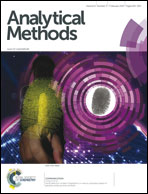An indirect competitive enzyme-linked immunosorbent assay for the determination of 3,4-dichlorobiphenyl in sediment using a specific polyclonal antibody†
Abstract
A specific polyclonal antibody targeting non-dioxin-like PCB 3,4-dichlorobiphenyl (PCB12) was obtained, and a sensitive indirect competitive enzyme-linked immunosorbent assay (ic-ELISA) was developed for the determination of PCB12 in sediment samples. Under optimal conditions, good linearity was achieved within a range of 0.06 to 6 μg L−1. The observed half-maximal inhibition concentration (IC50) was 2.37 μg L−1, and the limit of detection (LOD) was 0.021 μg L−1. This method was used for the detection of PCB12 in the sediment samples collected from the East China Sea adjacent to Shanghai, China. The concentrations of PCB12 in the samples ranged from 0.21 μg kg−1 to 8.59 μg kg−1. The recovery was from 81% to 105% and the CV values were from 2.8% to 8.4%. The consistency between the results obtained from ic-ELISA and GC-ECD was 98%. It further confirmed the reliability and accuracy of the ic-ELISA for rapid detection of PCB12 in the environment.


 Please wait while we load your content...
Please wait while we load your content...